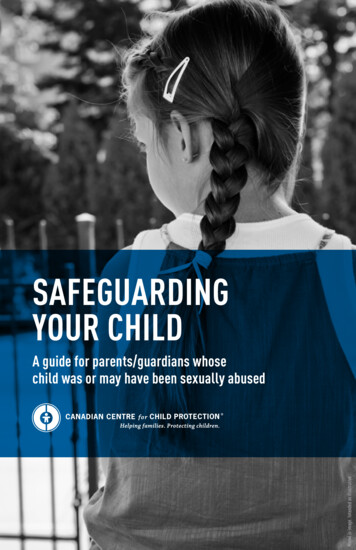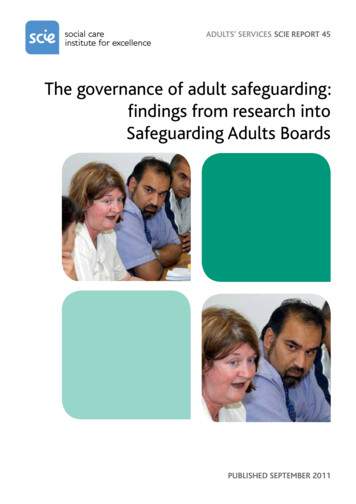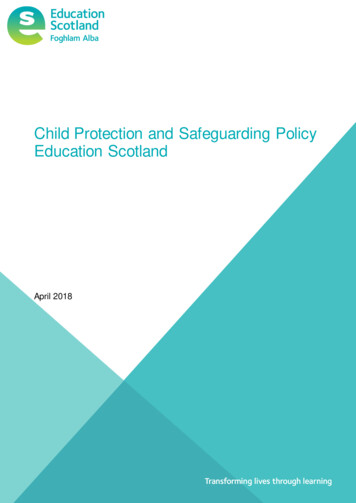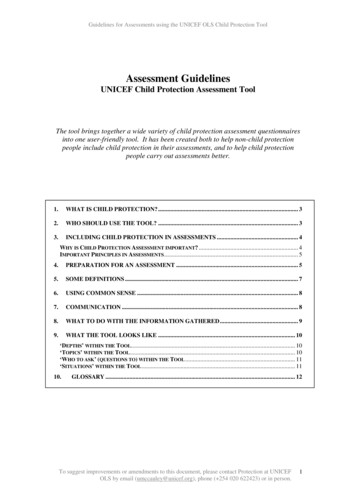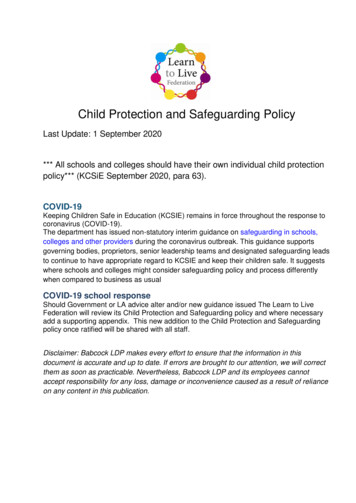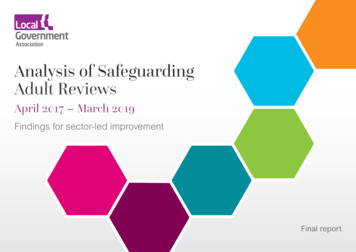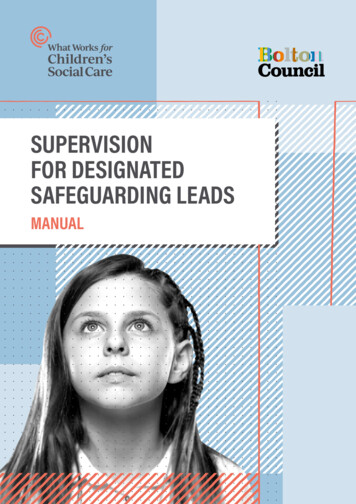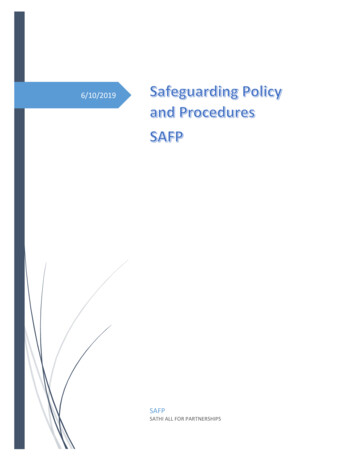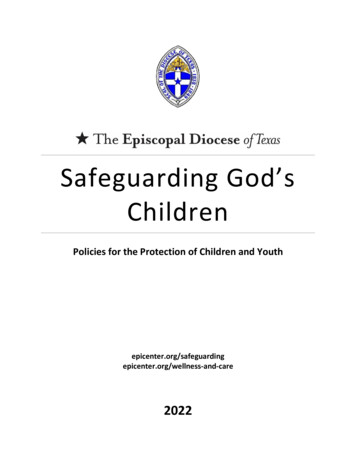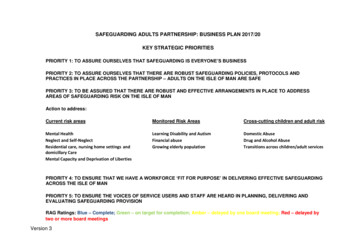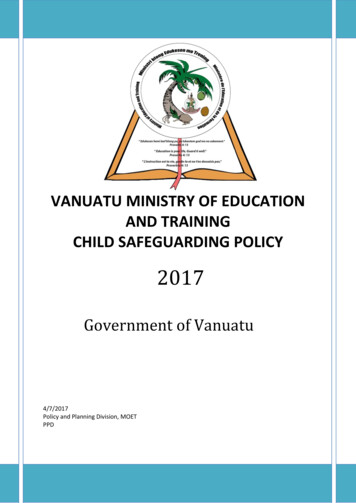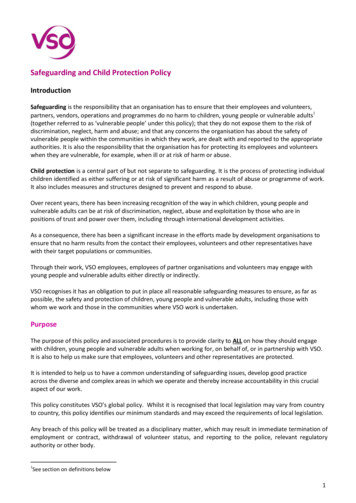
Transcription
Safeguarding and Child Protection PolicyIntroductionSafeguarding is the responsibility that an organisation has to ensure that their employees and volunteers,partners, vendors, operations and programmes do no harm to children, young people or vulnerable adults1(together referred to as ‘vulnerable people’ under this policy); that they do not expose them to the risk ofdiscrimination, neglect, harm and abuse; and that any concerns the organisation has about the safety ofvulnerable people within the communities in which they work, are dealt with and reported to the appropriateauthorities. It is also the responsibility that the organisation has for protecting its employees and volunteerswhen they are vulnerable, for example, when ill or at risk of harm or abuse.Child protection is a central part of but not separate to safeguarding. It is the process of protecting individualchildren identified as either suffering or at risk of significant harm as a result of abuse or programme of work.It also includes measures and structures designed to prevent and respond to abuse.Over recent years, there has been increasing recognition of the way in which children, young people andvulnerable adults can be at risk of discrimination, neglect, abuse and exploitation by those who are inpositions of trust and power over them, including through international development activities.As a consequence, there has been a significant increase in the efforts made by development organisations toensure that no harm results from the contact their employees, volunteers and other representatives havewith their target populations or communities.Through their work, VSO employees, employees of partner organisations and volunteers may engage withyoung people and vulnerable adults either directly or indirectly.VSO recognises it has an obligation to put in place all reasonable safeguarding measures to ensure, as far aspossible, the safety and protection of children, young people and vulnerable adults, including those withwhom we work and those in the communities where VSO work is undertaken.PurposeThe purpose of this policy and associated procedures is to provide clarity to ALL on how they should engagewith children, young people and vulnerable adults when working for, on behalf of, or in partnership with VSO.It is also to help us make sure that employees, volunteers and other representatives are protected.It is intended to help us to have a common understanding of safeguarding issues, develop good practiceacross the diverse and complex areas in which we operate and thereby increase accountability in this crucialaspect of our work.This policy constitutes VSO’s global policy. Whilst it is recognised that local legislation may vary from countryto country, this policy identifies our minimum standards and may exceed the requirements of local legislation.Any breach of this policy will be treated as a disciplinary matter, which may result in immediate termination ofemployment or contract, withdrawal of volunteer status, and reporting to the police, relevant regulatoryauthority or other body.1See section on definitions below1
DefinitionsAbuse - a violation of an individual’s human and civil rights by any other person or persons. It can take theform of physical, psychological, financial or sexual abuse, neglect or negligent treatment or commercial orother exploitation, resulting in actual or potential harm to the health, survival, development or dignity of achild, young person or vulnerable adult.Abuse can be a single act or repeated acts and can be unintentional or deliberate. Abuse often involvescriminal acts.Discriminatory abuse – abuse motivated by a vulnerable person’s age, race, nationality, sex, sexualorientation, disability, or other personal characteristic.Financial or material abuse - including theft, fraud, exploitation, pressure in connection with wills, property orinheritance or financial transactions, or the misuse or misappropriation of property, possessions or benefits.Neglect - the persistent failure to meet a vulnerable person’s basic physical and/or psychological needs, likelyto result in the serious impairment of his/her health or development. Examples include failure to provideadequate food, clothing and shelter, failure to protect them from physical or psychological harm or danger;failure to ensure adequate supervision (including the use of inadequate care-givers); or failure to ensureaccess to appropriate medical care or treatment. It may also include neglect of, or unresponsiveness to, avulnerable person’s basic emotional needs.Physical abuse – includes hitting, shaking, throwing, poisoning, burning or scalding, drowning, suffocating orotherwise causing physical harm, misuse of medication, restraint, or inappropriate sanctions.Psychological abuse - includes emotional abuse, threats of harm or abandonment, deprivation of contact,humiliation, blaming, controlling, intimidation, coercion, harassment, verbal abuse, isolation or withdrawalfrom services or supportive networks. Examples include not giving a vulnerable person opportunities toexpress their views, deliberately silencing them or ‘making fun’ of what they say or how they communicate. Itmay feature age or developmentally inappropriate expectations being imposed on a vulnerable person, whichmay include interactions that are beyond a vulnerable person’s developmental capability. It may involveserious bullying (including cyber bullying), or the exploitation or corruption of a vulnerable person.Sexual abuse - involves forcing, enticing or coercing someone to take part in sexual activities, whether or notthe vulnerable person is aware of what is happening. The activities may involve physical contact, includingassault by penetration (for example, rape or oral sex) or non-penetrative acts such as masturbation, kissing,rubbing and touching outside of clothing. They may also include non-contact activities, such as involving avulnerable person in looking at, or in the production of, sexual images, watching sexual activities, encouragingchildren to behave in sexually inappropriate ways, or grooming a child in preparation for abuse (including viathe internet). Sexual abuse can be carried out by adults or other children.Child – VSO regards a child as anyone under the age of 18 years, irrespective of the age of majority in thecountry in which the child lives or in their home country. It is widely recognised that children are generallymore vulnerable to abuse and exploitation due to factors such as age, gender, social and economic status,developmental stage, and dependence on others.Vulnerable person/people – for the purposes of this policy this is an umbrella term which covers children,young people and vulnerable adults.2
Vulnerable adult - a person, 18 years and above, who by reason of disability, age, gender, social andeconomic status, or illness, the context they are in, may be unable to take care of or to protect him or herselfagainst abuse, harm or exploitation.Youth or young people - individuals aged 15 to 25 (15 to 35 in some countries) – VSO recognises that thisgroup spans the categories of ‘children and ‘adults’ but regards young people as having particularsafeguarding needs and requiring distinct consideration aside from younger children and older adults.ScopeThis policy is mandatory for all VSO employees worldwide. For the purposes of this policy, ‘employee’ isdefined as anyone who works for or on behalf of VSO, either in a paid or unpaid capacity. This thereforeincludes directly employed staff, trustees, contractors, employees and volunteers of sub contractors,agency workers, consultants, volunteers, interns and all visitors to VSO work programmes and offices.It also covers implementing partners whom we fund, and who we expect to work under the policy as acondition of their involvement with VSO.This policy demonstrates how VSO will meet its legal obligations and reassure volunteers, employees,partners and members of the public:a) On what they can expect VSO to do to protect and safeguard vulnerable people.b) That they are able to safely voice any concerns through an established procedure.c) That all reports of abuse or potential abuse are dealt with in a serious and effective manner.d) That there is an efficient recording and monitoring system in place.e) That employees, volunteers, sub contracted agencies and partners receive appropriate induction onsafeguarding.f) That a robust ‘safe’ recruitment procedure is in place.There are additional procedures in place that apply to those that work or have contact with, either directly orindirectly, children, young people or vulnerable adults or who live in communities alongside them.Policy StatementVSO has zero tolerance against abuse and exploitation of vulnerable people. VSO also recognises thatsafeguarding is everyone’s responsibility and that it has an obligation to put in place reasonable measures toensure, as far as possible, the safety and wellbeing of vulnerable people with whom we work and those in thecommunities in which we live.VSO works to the following key principles to protect vulnerable people: Everyone has an equal right to protection from abuse and exploitation regardless of age, race, sex,sexual orientation, marriage and civil partnership, pregnancy or having a child, gender reassignment,language, religion, political or other opinion, national, ethnic or social origin, property, disability, birthor other status. The best interests of the vulnerable person are paramount and shall be the primary consideration inour decision making.3
VSO will take responsibility to meet our obligations regarding our duty of care towards vulnerablepeople, and take action where we believe that a child, young person or vulnerable adult is at risk or isactually harmed. VSO will ensure that employees and volunteers are inducted in our Safeguarding Standards (Appendixand procedures as a key part of the recruitment and on boarding process. VSO will ensure that all partners are informed and in compliance with our Safeguarding Standards.When working with or through partners or sub contracted agencies, VSO will ensure that theirsafeguarding procedures are consistent and in line with the principles and approaches set out in thispolicy. VSO recognises that an element of risk exists, and while we may never be able to totally remove this,we need to do all we can to reduce it or limit its impact. VSO respects confidentiality and has a responsibility to protect sensitive personal data. Informationshould only be shared and handled on a need to know basis, that is, access to the information must benecessary for the conduct of one's official duties. Only individuals who have legitimate reasons toaccess the information are allowed to receive it. VSO commits to monitoring the implementation of the safeguarding policy. This policy will be reviewedevery three years and earlier if necessary. Cultural sensitivity; VSO seeks always to work in ways which are culturally sensitive and that respectthe diverse nature of the people we work with. We recognise that there are many different ways ofthinking and taking care of vulnerable people and making sure they are protected. It is acknowledgedthat protecting these groups of individuals and being culturally sensitive can be a difficult balancing act,especially given the situation in many of the countries where we work. As an international organisation,we endorse the United Nations Convention on the Rights of the Child general principle, that all therights guaranteed by it must be available to all children without discrimination; and article 19 whichaccords equal rights to protection for children from abuse. Every child matters everywhere in the world.Culture must not be used as an excuse to abuse children, young people or vulnerable adults.Your People Business Partner representative is available to give guidance on how to interpret the policy andits application to the local context.ResponsibilitiesAllAll employees, volunteers, consultants, agency staff, sub contractors, partner organisations and visitors areobliged to follow this policy and maintain an environment that prevents exploitation and abuse and whichencourages reporting of breaches of this policy using the appropriate procedures.All people working with VSO will: Read, understand and adhere to the VSO Global Safeguarding Policy and VSO Global Code of ConductPolicyStrive to promote a zero tolerance approach to discrimination, sexual harassment and abuse in allworking environmentsStrive to develop relationships with all stakeholders which are based on equality, trust, respect andhonesty4
Place the safety and welfare of children and vulnerable people above all other considerationsReport any concerns they may have about the welfare of a child or vulnerable personReport any concerns they may have about the behaviour of a VSO representative in relation tosafeguardingIn a one-to-one situation with a child or young person, where privacy and confidentiality are important,try to make sure that another adult knows the contact is taking place and why. If possible ensureanother adult is in sight and that the child or young person knows another adult is aroundAll people working with VSO will not: Sexually harass, assault or abuse another personPhysically harass, assault or abuse another personEmotionally abuse another person, such as engaging in behaviour intended to shame, humiliate,belittle or degradeCondone, or participate in behaviour which is abusive, discriminatory, illegal, or unsafeDevelop, encourage or fail to take action of relationships with children or other vulnerable people whichcould in any way be deemed sexual, exploitative or abusiveAct in ways that may be violent, inappropriate or sexually provocativeAgree with a child to keep a secret which has implications for their safety or the safety of other youngpeople.ManagersManagers at all levels are responsible for ensuring employees, volunteers, consultants, visitors and partnerorganisations are aware of the policy and are supported to implement and work in accordance with it, as wellas creating a management culture that encourages a focus on safeguarding. They must ensure that they areresponsive, acting immediately if they become aware of any safeguarding concerns, and supportive towardsemployees or volunteers who complain about breaches in this policy.5
Designated Safeguarding OfficersDesignated safeguarding officers are responsible for handling reports or concerns, about the protection ofvulnerable people, appropriately and in accordance with the procedures that underpin this policy.Your People Business Partner will act as your designated safeguarding officer.The lead designated safeguarding officer is responsible for: monitoring and recording safeguarding concernsensuring referrals to the relevant authorities happen without delayupdating safeguarding training for all staffensuring this policy is reviewed every 3 years or earlier if necessaryensuring it is implemented throughout the organisation and safeguarding training givenensuring monitoring and recording procedures are implementedVSO Executive BoardThe VSO Executive Board is responsible for ensuring the effective implementation of this policy andassociated procedures and ensuring that everyone linked with VSO is equipped and supported to meet theirresponsibilities.TrusteesThe Board of Trustees holds ultimate accountability for this policy.Procedure OverviewRecruitment and Selection: Safe recruitment and vetting processes are followed for all volunteers, employees, consultants andpartners (For more detailed guidance, refer to the Global Recruitment and Selection Policy) Where an employee, volunteer or partner is engaged in ‘regulated activity’ (direct work with vulnerableindividuals), a criminal background check will be undertaken as part of the recruitment process.(For more detailed guidance, contact your People Business Partner, Country Director or functionallead.) All VSO employees and volunteers must sign and abide by this safeguarding policy and the Code ofConduct. The code sets out the standards of practice we expect of employees and volunteers - in termsprofessional competence, integrity, acting as a representative and in safeguarding - which support ourvision, mission and values. (For more detailed guidance, refer to the Global Code of Conduct).Induction and Support:Advice , support and training on safeguarding will be provided to all employees and volunteers on:o What they should do in the event of a disclosureo What to do if they have concerns about the welfare of a childo How to recognise signs of abuseo What to do if they have concerns about a VSO employee, volunteer, or employee of a partnerorganisationo Where to go for advice and support within the organisation Ensure that clear processes for reporting and dealing with safeguarding concerns and incidents arewidely communicated, regularly reviewed and consistently applied. Where allegations are made aboutan employee, careful consideration must take place about the appropriateness of the personcontinuing to work with VSO. ( For more detailed guidance, refer to the Global Disciplinary Policy)6
Data ProtectionEnsure that personal information is kept confidential unless we have the agreement of the individual and/ortheir parent/guardian, except where it is necessary to pass this to a specialised child welfare or lawenforcement agency in relation to a safeguarding incident. (For more detailed guidance, refer to theData Protection Policy and Statement).Minimum StandardsWhere employees or volunteers are contracted by other employers, or when working with partners, subcontracted agencies, VSO will brief them on our safeguarding policy and ask for information on how theorganisation works to protect vulnerable people and ensure that they meet our SafeguardingStandards.Social MediaVSO has a policy regarding the media and the use of actual names, images, including photographs andrecordings (the ‘Social Media Policy’). This should be applied in all situations. Specifically relating toprotection of children, young people and vulnerable adults, we will: Use names and images of children, young people or vulnerable adults which are respectfuland not expose them to further vulnerability (not degrading or showing sexual images ofchildren naked or partially clothed). Reproduce images and use names of children only where we have the written permission oftheir parents / guardians using a consent form (Appendix 2). Reproduce images and use names of young people and vulnerable adults only where we havetheir written permission or that of their parents/guardians, whichever is the most suitable. Make clear to vulnerable people and their families that agreement to providing informationor images is not a condition of involvement in VSO activities and programmes. Inform employees, volunteers and partners about the VSO policy in relation to the use oftechnology (the IIT Policies), and understand that they must not use this technology for thepurpose of accessing, producing or distributing any information or violent or sexual imagesthat are harmful to vulnerable people. This includes adult pornography.Ensure that VSO has a format for carrying out and implementing risk assessments at all levels of theorganisation.Train and support the designated safeguarding officers in their work and in any action they may need to take inorder to protect vulnerable people.Raising and responding to concernsVSO places a mandatory obligation on all employees, volunteers, contractors and partners to report concerns,suspicions, allegations and incidents which indicate actual or potential abuse or exploitation vulnerablepeople or which suggests this policy may have in any other way been breached. It is not the responsibility ofthe employees to decide whether or not abuse has taken place, however, concerns should be raised with anindividual’s line manager, functional lead or a designated safeguarding officer who will initiate the procedurefor dealing with suspected or actual incidents of abuse. (For details refer to the Safeguarding ManagementPathway for reporting concerns).7
Designated Safeguarding Officers are responsible for ensuring that the reporting procedure is followed so thatsuspected or actual cases of abuse are responded to appropriately and consistently, and referred to therelevant statutory authority.To ensure that all such situations are handled appropriately and effectively: Reports must be made, and decisions and actions taken ( For details, refer to Managing SafeguardingConcerns) VSO is not an investigative authority. It is essential that referrals are made to the relevant lawenforcement agency to ensure that appropriate protection and support is given to the vulnerableindividual, and that any evidence is collected in accordance with the law. All sensitive and personal data must be kept confidential (including the names of anyone who makes areport of abuse), and be shared on a strictly ‘need to know basis’, that is, access must be necessary forthe conduct of one’s official duties. Where a VSO employee is the subject of an investigation, the lead designated safeguarding officer willlead the case.Policy number: 1887062Version: 8Date created: May 2015Date of last update: 2 January 2018Responsible owner:VSO People and Organisation Development, Executive DirectorAppendix 1: VSO Safeguarding Standards7
This standard framework is from the Keeping Children Safe “Child Safeguarding Standards” and adapted foruse for VSO. Each standard can be met in whole, in part or not met.1. PolicyStandard1.1 The organisation has a clear safeguarding policythat seeks to prevent harm to children, youngpeople and vulnerable adults1.2 Policies are publicised to staff, beneficiaries andwider communities2. People2.1 The organisation places clear responsibilitiesand expectations on its staff and associates andsupports them to understand and act in line withthese2.2 Key staff are designated at different levels withclearly defined roles and responsibilities.2.3 There are written guidelines for appropriate andinappropriate behaviour2.4 There are appropriate learning opportunities todevelop and maintain the necessary attitudes, skillsand knowledge to keep vulnerable people safe.4. Accountability3. Procedures3.1 Organisations carry out local mapping exerciseswhich provide information on the legal,social welfare and child protection arrangements.Potential evidence of standard being met A copy of the policy, signed bythe management board ortrustees For programme or recruitment partners,thator summaryinto PolicyVSO volunteersaretranslatedinformed aboutthe policylocallanguages Examples of ways the policy has beenpromoted, including to children,young people or other communitymembers as necessary Clear responsibilities for a DesignatedSafeguarding Officer at appropriate level Job descriptions with clear expectationson those with contact with vulnerablepeopleJob descriptions for VSO long-termvolunteer include details of any contactwithvulnerablepeopleAwrittencode ofconduct; evidence ofthis being shared to staff and volunteersA copy of training plans, courseattendance records and courseevaluations.Evidence of induction for VSO volunteersto relevant safeguarding issuesLegal requirements are included in policies 3.2 Safeguarding risks and mitigation strategies areincorporated into existing risk assessment processesat all levels.3.3 Safeguarding issues are integrated intoprogramme design, delivery and evaluation3.4 There are procedures for responding tosafeguarding concerns arise4.1 Implementation of safeguarding policies andprocedures is monitored4.2 Learning from issues captured and informedfuture policy and procedure reviews4.3 Policies and procedures reviewed at least everythree years Risk assessments include appropriateand relevant risksEvidence of mitigationstrategies implementedRisk assessments shared with VSOvolunteersof safeguarding issues inEvidenceproject proposals, plans, needsassessments,etcA copy of a concern/allegationmanagementCopies of reporting to boards, donors, etcCopies of minutes of meetings toreview practiceIncident reports producedEvidence of review in annual plans /strategies8
Appendix 2Sample Parental Consent for Photographic/Film Use of Children under 18 years of age/vulnerable adult:I, (adult’s name)Of (address)Being the child/children’s/ parent or legal guardian, hereby give permission for(School name)(School address)To take and use publicity photographs/film of(child/children’s name/s)Age of childAge of childAge of childI also consent to use of the photos for publicity, marketing, and advertising for VSO projects. I agree that thephotos/film may be combined with other images, text and graphics and be cropped, altered or modified inany way that VSO deems appropriate.I consent to the provision of this form and the details within it to VSO, and to their storing these on adatabase.I understand that the child’s/children’s name/s will not be given to press or public without my consent. I alsounderstand that I may cancel this permission in writing, and that VSO will take all reasonable steps to ensurethat the photograph/film is withdrawn from future use.I further understand that I shall receive no remuneration for this assistance.Signed:Date:9
1 Safeguarding and Child Protection Policy Introduction Safeguarding is the responsibility that an organisation has to ensure that their employees and volunteers, partners, vendors, operations and programmes do no harm to children, young people or vulnerable adults1 (together referred to as 'vulnerable people' under this policy); that they do not expose them to the risk of
